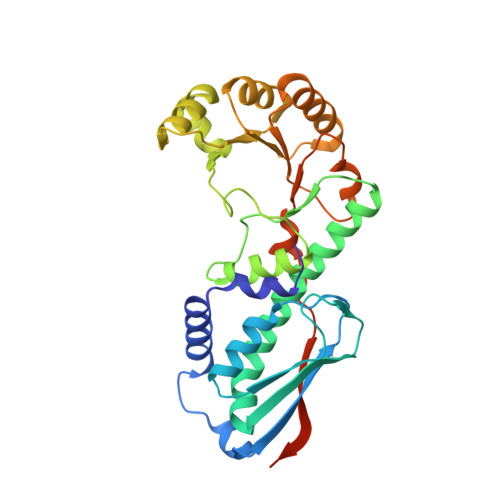Structural Insights into the Quaternary Catalytic Mechanism of Hexameric Human Quinolinate Phosphoribosyltransferase, a Key Enzyme in de novo NAD Biosynthesis
Youn, H.-S., Kim, T.G., Kim, M.-K., Kang, G.B., Kang, J.Y., Lee, J.-G., An, J.Y., Park, K.R., Lee, Y., Im, Y.J., Lee, J.H., Eom, S.H.(2016) Sci Rep 6: 19681-19681
- PubMed: 26805589
- DOI: https://doi.org/10.1038/srep19681
- Primary Citation of Related Structures:
5AYX, 5AYY, 5AYZ - PubMed Abstract:
Quinolinate phosphoribosyltransferase (QPRT) catalyses the production of nicotinic acid mononucleotide, a precursor of de novo biosynthesis of the ubiquitous coenzyme nicotinamide adenine dinucleotide. QPRT is also essential for maintaining the homeostasis of quinolinic acid in the brain, a possible neurotoxin causing various neurodegenerative diseases. Although QPRT has been extensively analysed, the molecular basis of the reaction catalysed by human QPRT remains unclear. Here, we present the crystal structures of hexameric human QPRT in the apo form and its complexes with reactant or product. We found that the interaction between dimeric subunits was dramatically altered during the reaction process by conformational changes of two flexible loops in the active site at the dimer-dimer interface. In addition, the N-terminal short helix α1 was identified as a critical hexamer stabilizer. The structural features, size distribution, heat aggregation and ITC studies of the full-length enzyme and the enzyme lacking helix α1 strongly suggest that human QPRT acts as a hexamer for cooperative reactant binding via three dimeric subunits and maintaining stability. Based on our comparison of human QPRT structures in the apo and complex forms, we propose a drug design strategy targeting malignant glioma.
- School of Life Sciences, Gwangju Institute of Science and Technology, Gwangju 500-712, South Korea.
Organizational Affiliation:
















